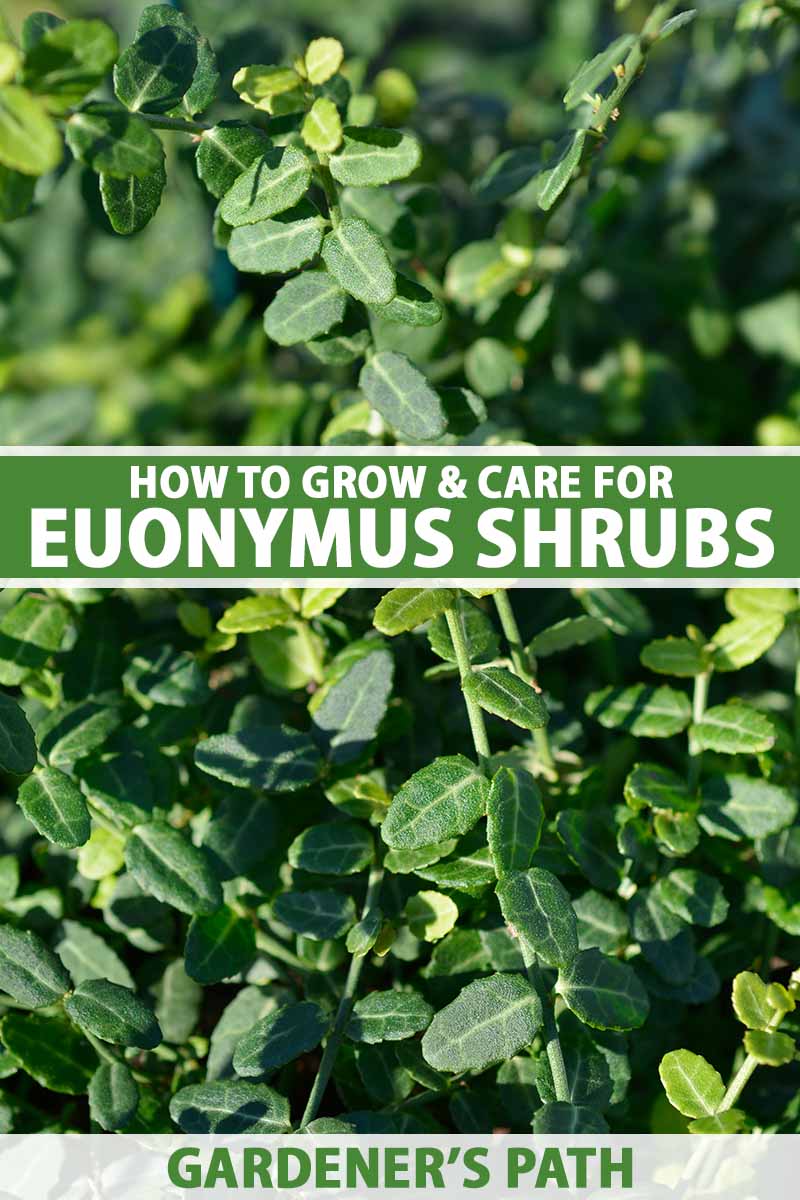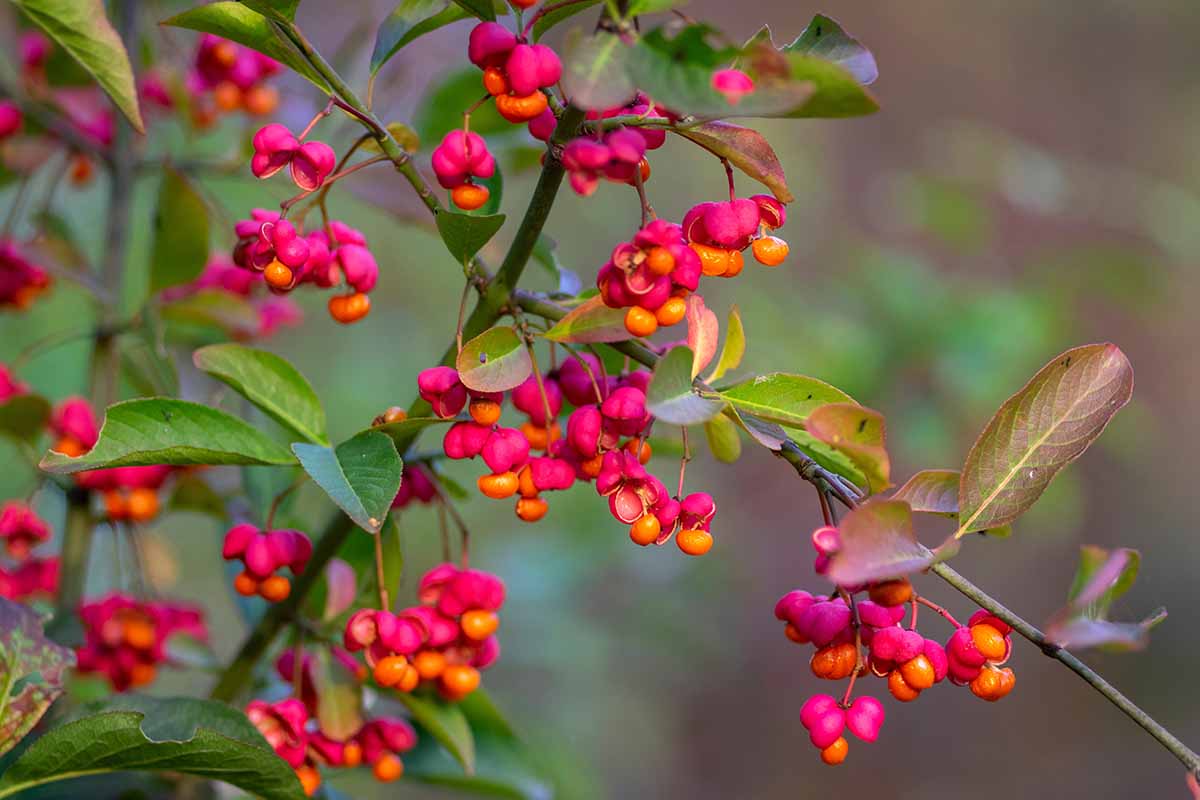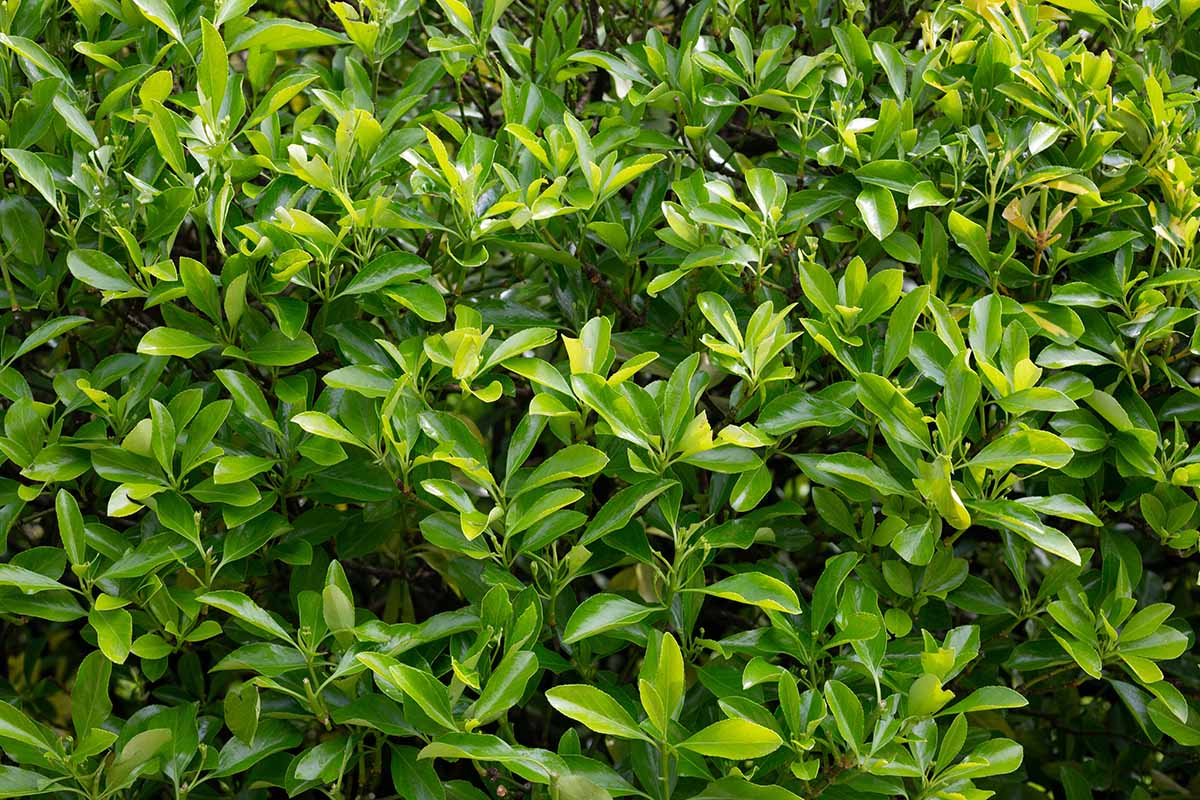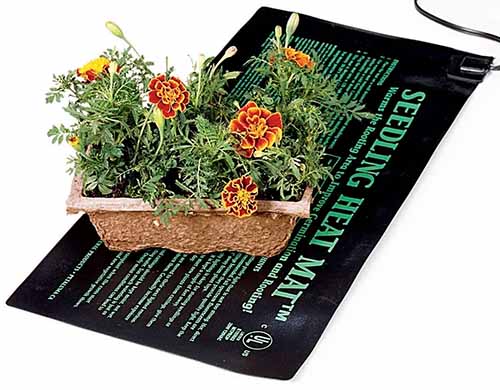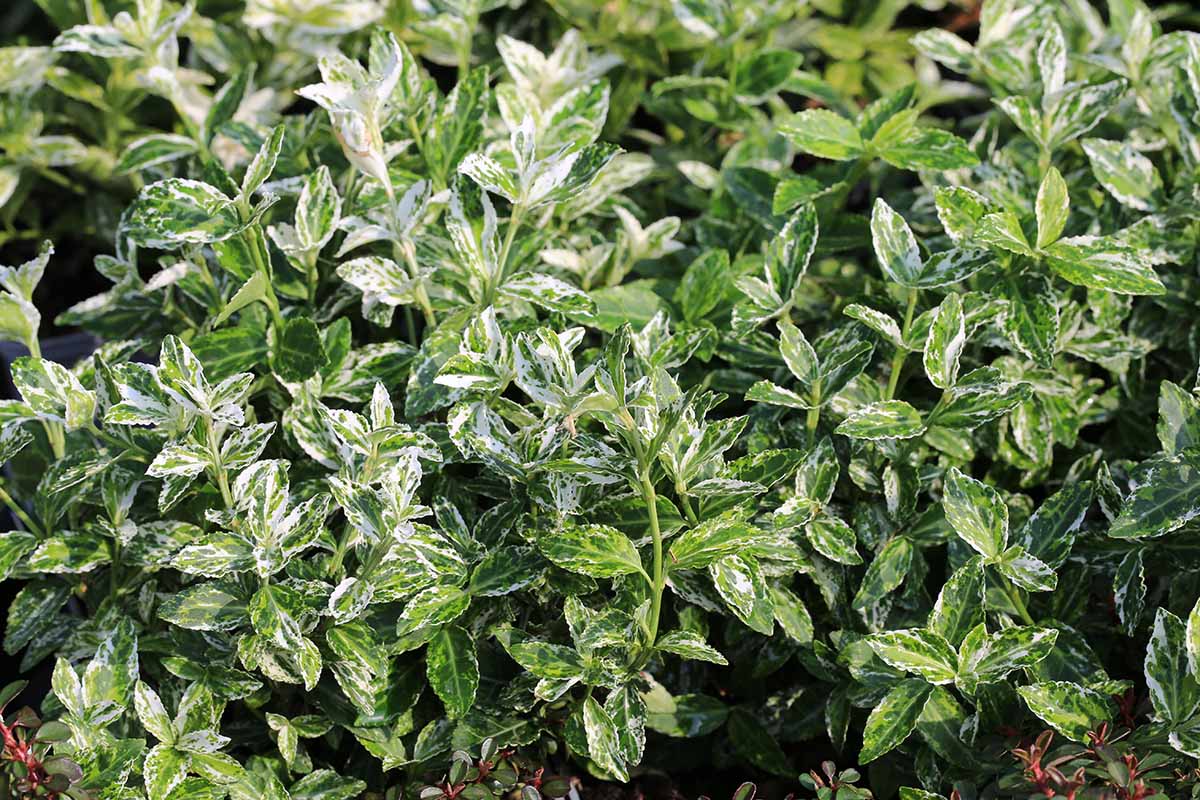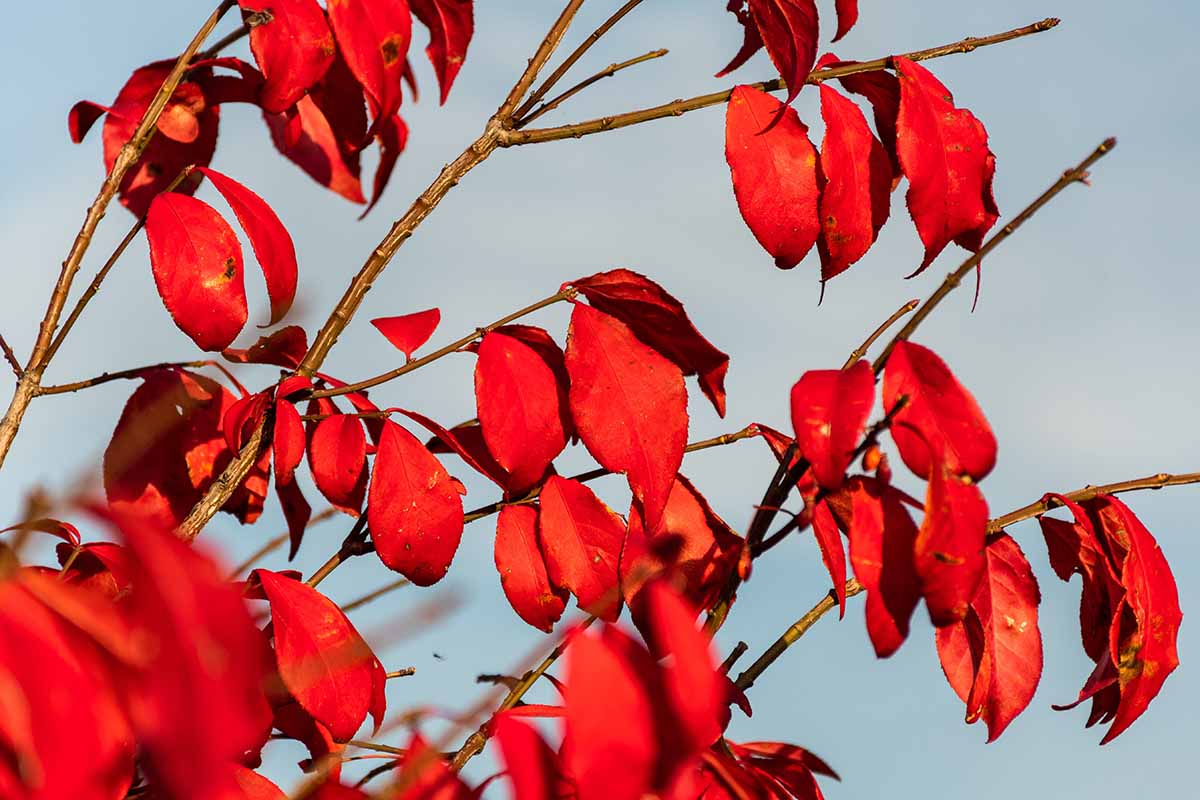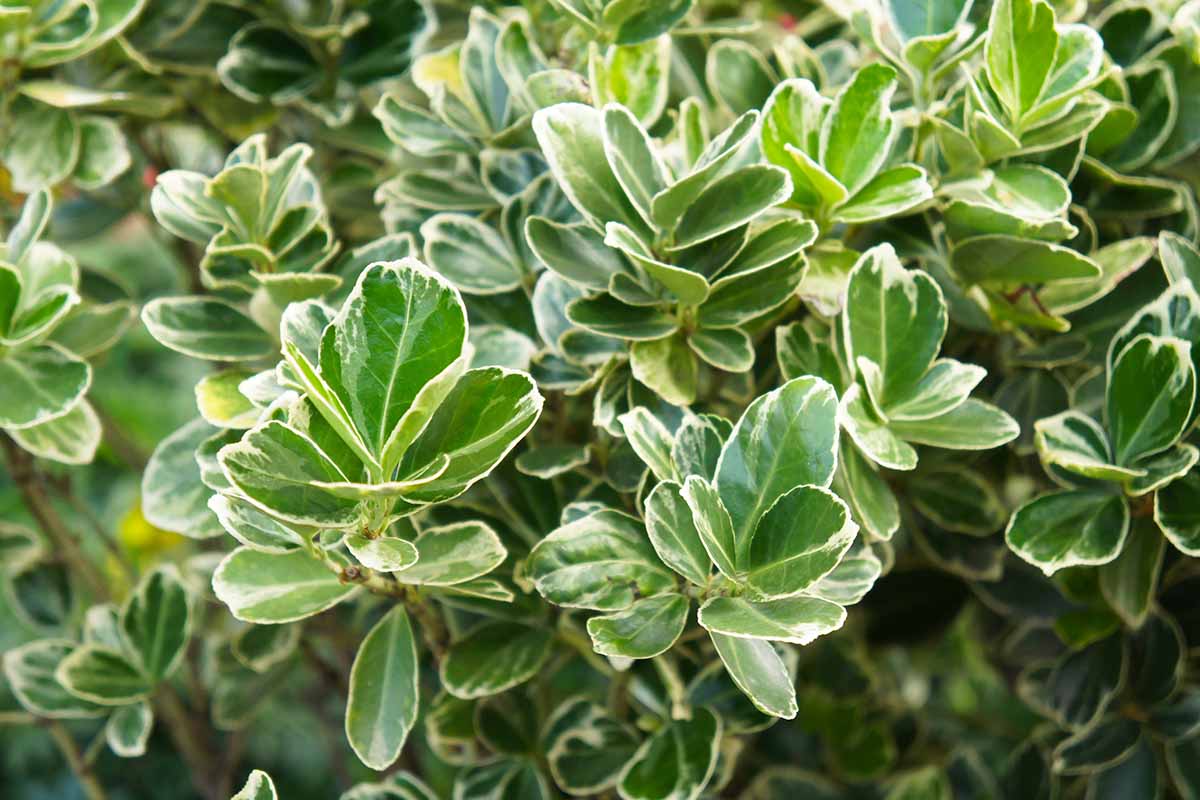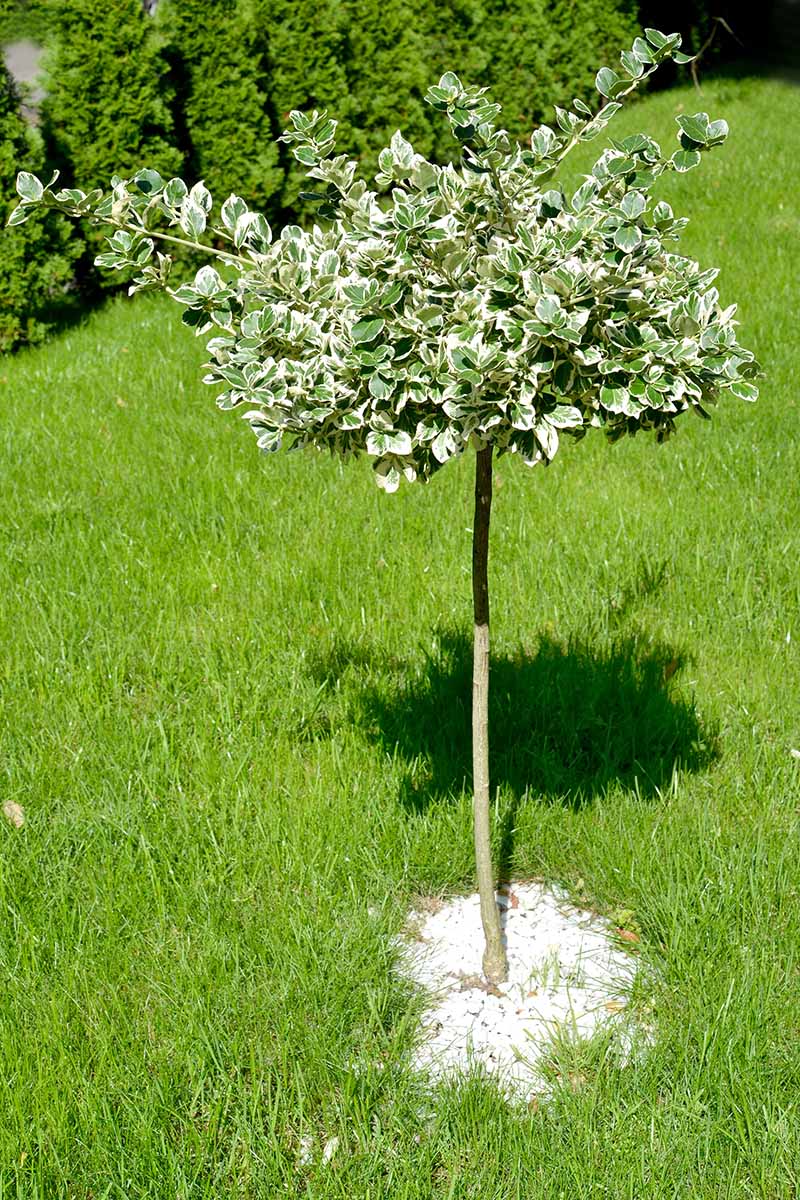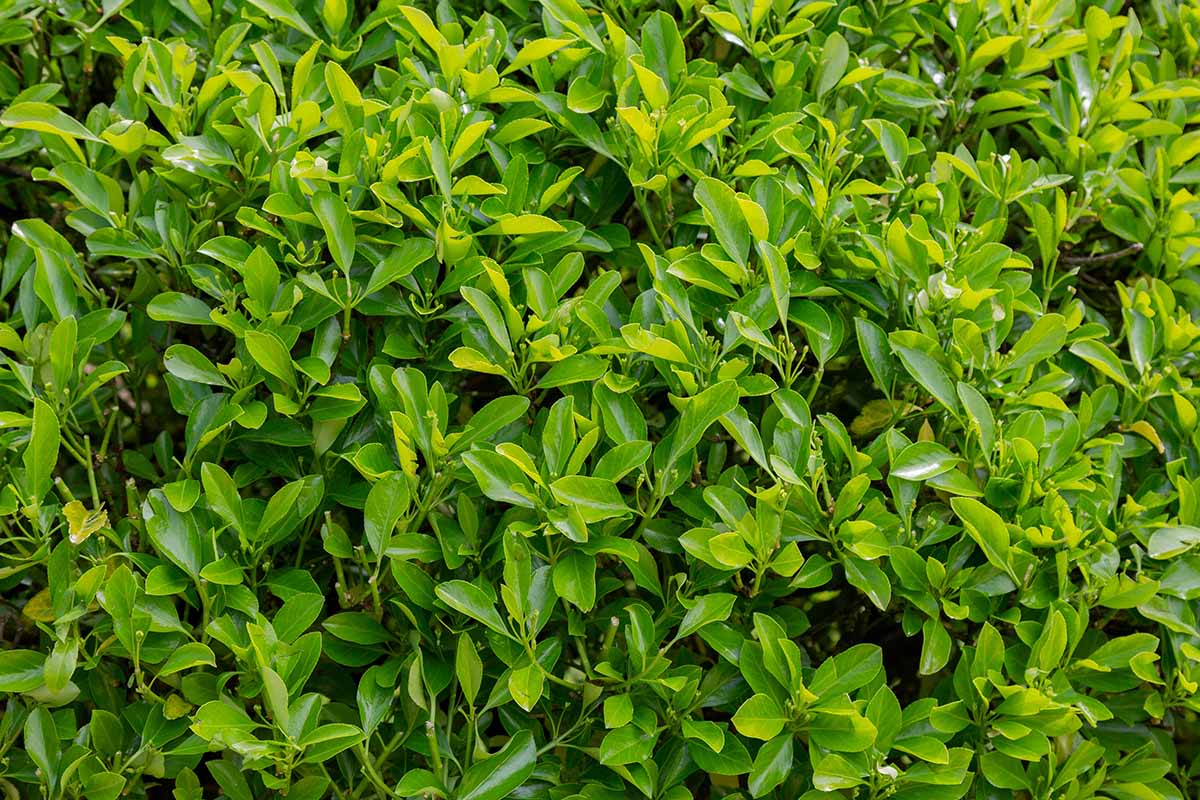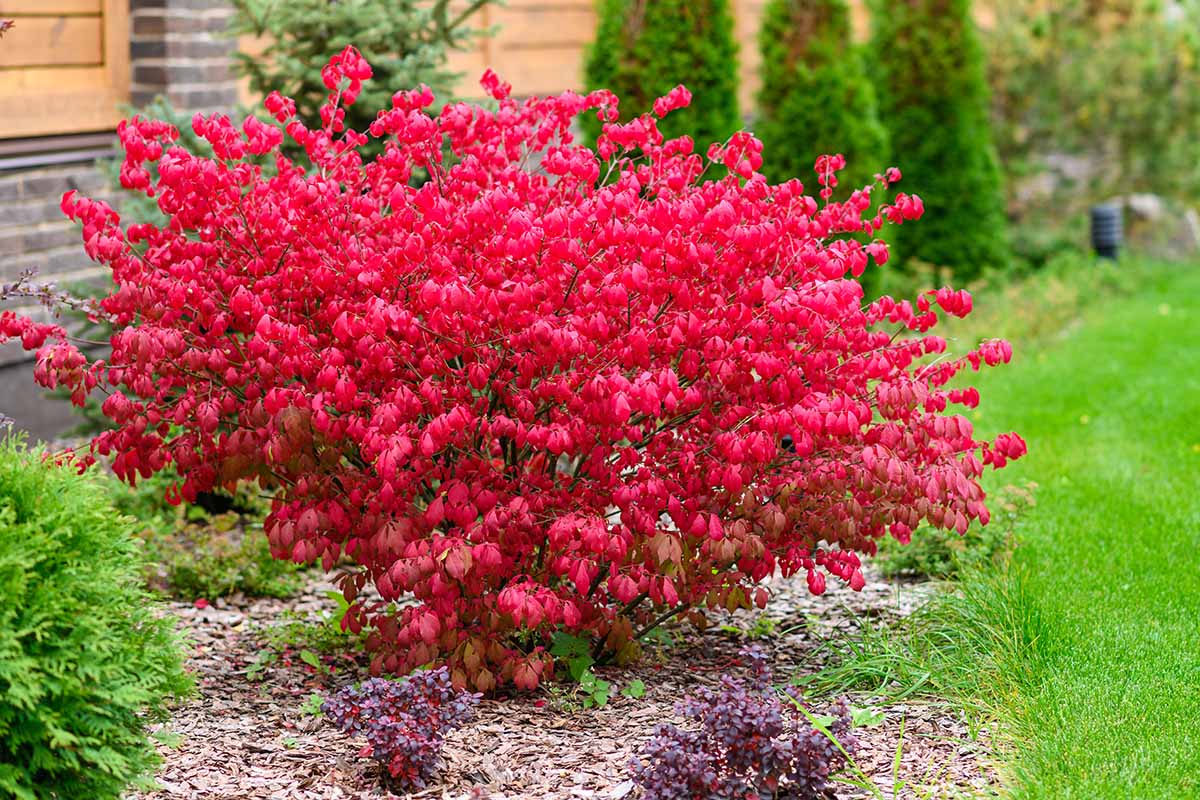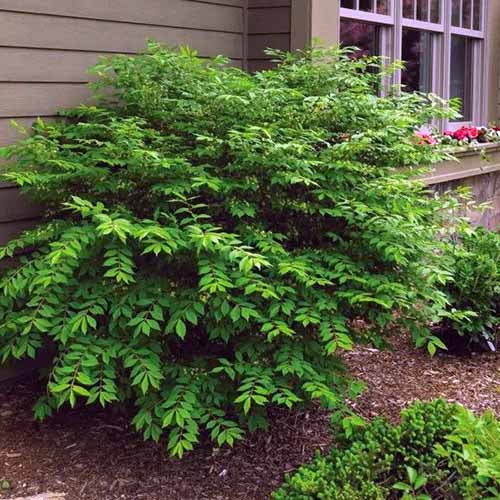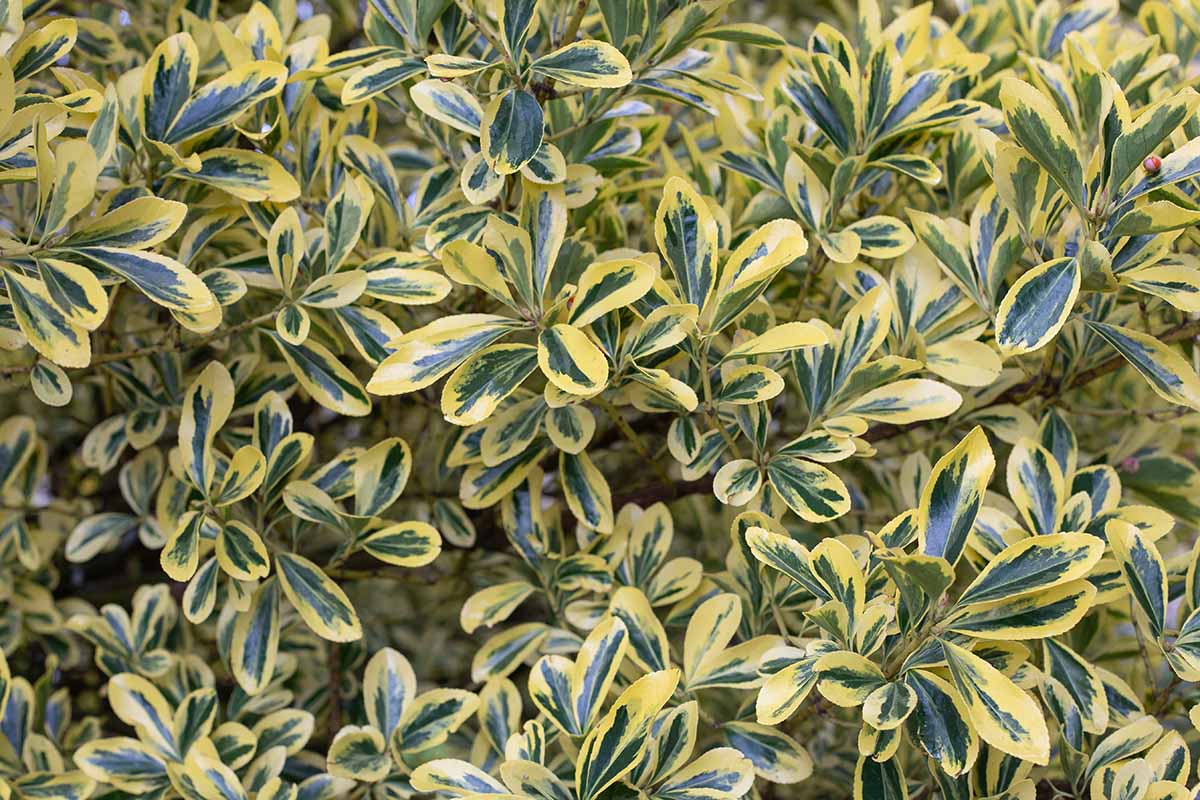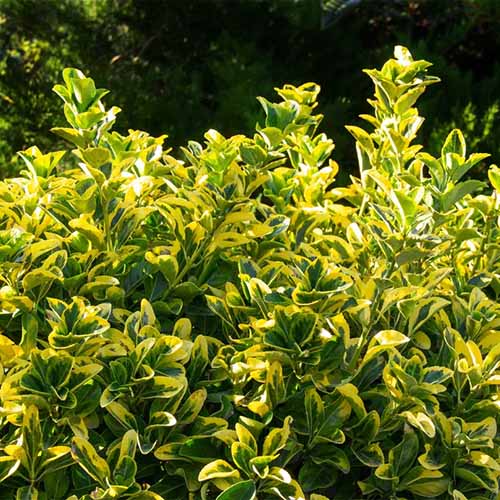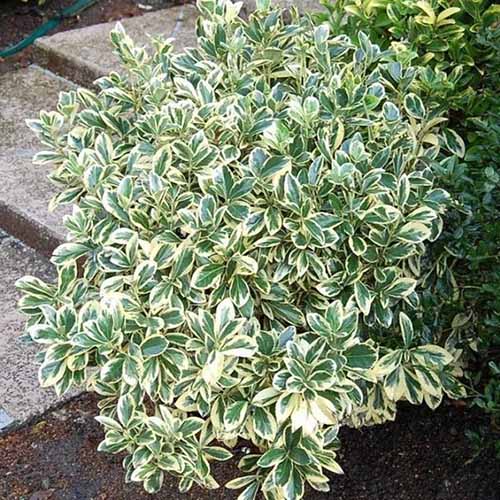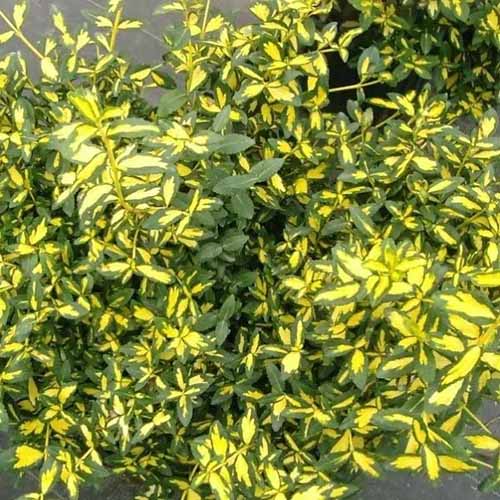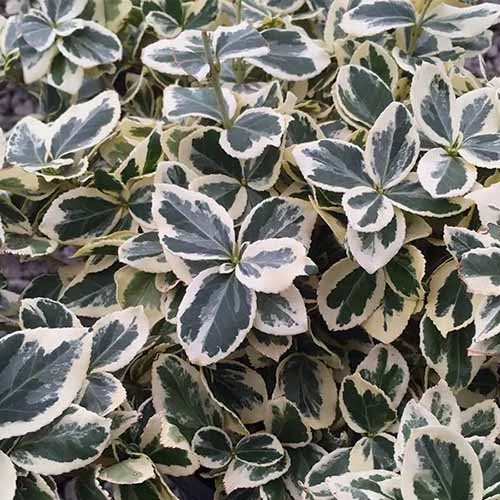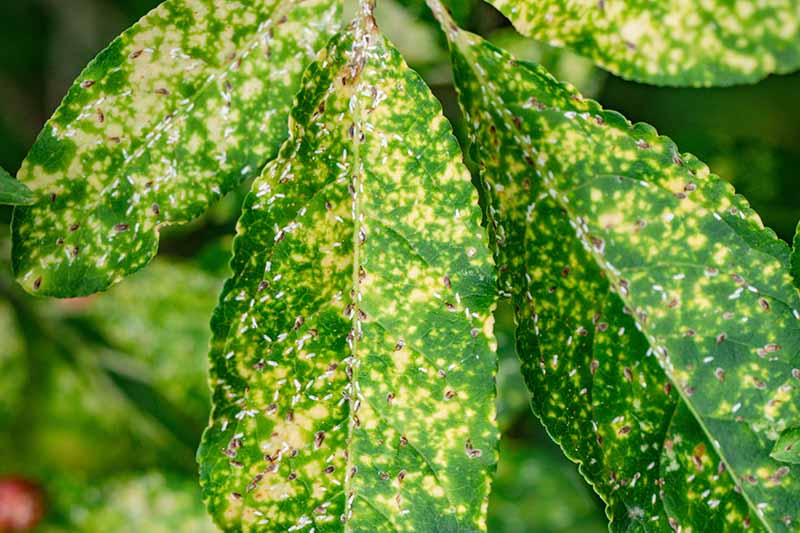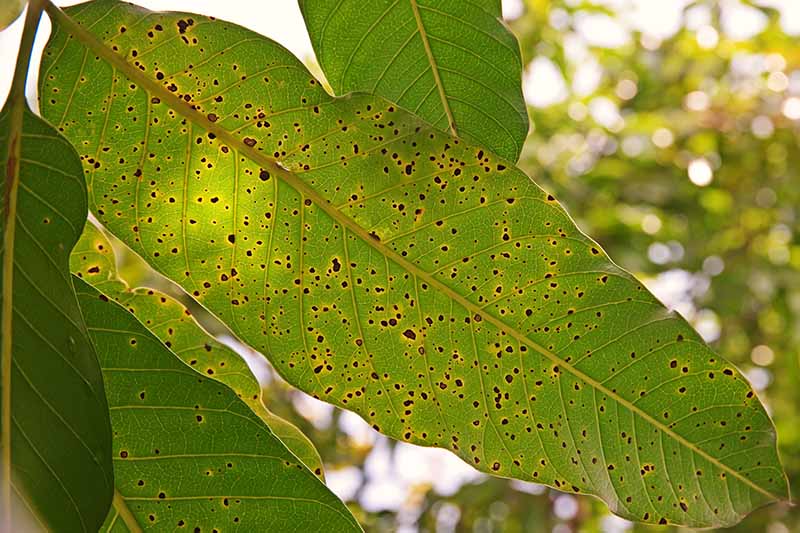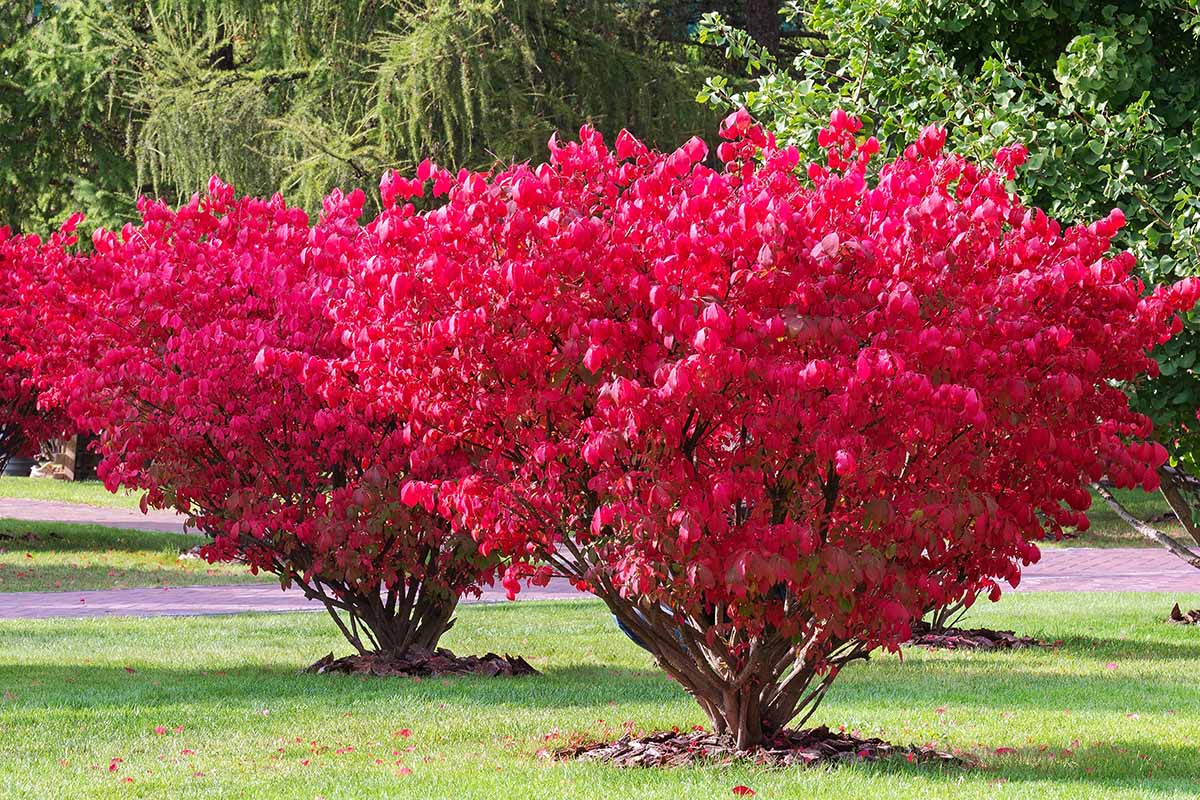This botanical genus is pretty much a one-stop shop of trees, shrubs, and vines, both deciduous and evergreen. You could fill a landscape with nothing but Euonymus if you wanted to, and it would still end up looking pretty neat. We link to vendors to help you find relevant products. If you buy from one of our links, we may earn a commission. And it goes without saying that they’re beautiful. The evergreen species have gorgeous year-round foliage, and deciduous species have leaves which change from good to great as autumn arrives. The flowers and fruits are pretty inconspicuous when compared to the leaves and branches, but they provide a tasty visual treat as well upon closer examination. As a whole, these plants aren’t too high-maintenance. They definitely require some watering, pruning, and preventative health care, but being a plant parent to these guys is pretty smooth sailing overall. Drought hardiness, fire resistance, and full shade tolerance are pretty sweet fringe benefits, I might add. We’ve got a guide for you that’ll serve as a crash course in Euonymus cultivation. Propagation instructions, growing tips, health care advice, and more are all covered. By the end, you’ll have the know-how required to care for these bad boys yourself. Here’s what awaits, Euonymus enthusiasts!
Cultivation and History
The name Euonymus is a fusion of the Greek suffix eu-, meaning good, and onyma, meaning name. At one point, these plants were known for poisoning livestock, so I suppose the “good name” moniker was conceived ironically. Pro tip: don’t consume this plant, it be poisonous. Most Euonymus species hail from East Asian nations such as China, Japan, and Korea. Many species made their way into other countries, whether intentionally introduced as ornamental plantings, unintentionally spread as invasive species, or both. Six species are native to North America, including E. atropurpureus, the Eastern wahoo, and E. americanus, commonly known as strawberry bush. Birds are attracted to Euonymus berries, which ends up spreading the seeds rapidly – especially to areas where these plants may not be welcome. Besides East Asia, Euonymus can be found – and has oftentimes naturalized – in parts of Africa, Central America, Europe, North America, Southeast Asia, and the West Indies. Certain species are classified as invasive in many places, so some folks aren’t the biggest fans of this type of plant. But regardless of your feelings about them ecologically, there’s no denying the beauty of Euonymus.
Propagation
With many different species comes many ways to propagate. You can propagate Euonymus by sowing seeds, taking cuttings, layering, or transplanting.
From Seeds
First things first: you need seeds. In autumn, pick ripened Euonymus berries and remove their seeds. Put the harvested seeds into a strainer, rinse, then air dry on a paper towel. Fill a baggie with moist sand, then bury the seeds within said sand. To stratify the seeds, refrigerate the baggie for at least three months at 40°F. Come next summer, it’ll be sowing time. When it’s 70 to 85°F outside, sow the seeds a quarter-inch deep in well-draining garden soil, with enough space between them to accommodate for their mature sizes. Water in the seeds upon sowing, and mulch the seed beds with pine straw to keep weeds down while also allowing in sunlight and moisture. Keep the soil moist until the seeds germinate, in about eight weeks.
From Cuttings
Via Layering
My preferred layering method with Euonymus is tip layering, which works especially well with vining species like E. fortunei. Hormex Rooting Powder Stick the IBA-dipped ends of the cutting into a tray that’s filled with a 50-50 rooting medium of vermiculite and sand. Make sure to keep the medium moist via misting without drenching it. The cuttings will need to be indirectly lit, and kept at 70 to 85°F. If you are unable to keep the environment at that temperature, then warming pads like the ones sold at Gardener’s Supply will add 10 to 20°F to the heat already provided by the environment. Heating Mat Once strong root systems have developed, in four to eight weeks or so, you’ll want to start the hardening off process. Bring the cuttings outside for 30 to 60 minutes one day, and add 30 to 60 additional minutes each day until the cuttings are conditioned to survive a full day outdoors. After that, they’re ready for transplanting. Select a healthy, flexible stem during the summer and make a slanting cut a quarter to half of the way between the tip and where it connects to the mother plant. Then, stick the tip – still attached to the mother plant – into the adjacent soil, bury it, and keep it affixed with a stone or horticultural staple. Keep the soil around the layered tip moist until a new shoot grows from it. At this point, congratulations! It’s time for transplanting.
From Transplants
If you’re transplanting Euonymus, you’ll want to do so in autumn. Prior to planting, prepare the site with a couple of inches of fresh compost or rotted manure tilled into the soil. Dig a hole slightly wider than and just as deep as the transplant’s root system. Come transplanting time, lower the plant into the ground. Backfill the gaps in the hole with nearby soil, and water the whole thing in. Keep the planting site well irrigated until the plant becomes established.
How to Grow
Now that you’ve got a Euonymus in the ground, it’s time to take care of it. The following tips are general recommendations for the genus, but depending on the particular species you’re growing, you may have to modify them a bit.
Climate and Exposure Needs
These plants need to be in USDA Hardiness Zones 4 to 8 in order to thrive. Also, they need full sun or partial shade exposure. Full shade is tolerable, but growth won’t be optimal.
Soil Needs
Moist, well-draining, and fertile soil is what’s necessary for Euonymus, so provide soil with a loamy texture and an adequate organic matter content. These plants do well with a variety of pH levels, so shoot for a range of 6.0 to 8.0.
Water and Fertilization Needs
Deeply irrigate Euonymus whenever the top three inches of soil are dry. If your area gets regular rainfall, you may not even have to water much. Supplemental fertilization is only necessary if the soil you’re working with is particularly lean. If that’s the case, then an annual autumn application of all-purpose, balanced fertilizer to the root zone is acceptable.
Growing Tips
Full sun and partial shade exposures are ideal, but full shade is tolerable in a pinch.Grow this plant in moist, fertile, and well-draining soil.Whenever the top three inches of soil are dry, it’s time to water.
Pruning and Maintenance
Euonymus requires some work to keep it looking fresh, but that’s the price you pay for awesome foliage. Whether the vines grow out of bounds or crop up in random places, these plants can get pretty weedy, so pruning undesirable growth and pulling sprouts as they appear can keep them growing where you want them to. Pruning species fit for hedging such as E. alatus or E. japonicus can help keep them at an ideal shape. In addition, removing dead or infected branches helps to prevent the spread of disease. Pruning should take place in early spring, after the last frost of winter. This will help prevent frost damage in freshly cut plant tissues. But removing decaying and sickly branches, as well as weeding, can be done at any point in the year.
Insects
Insects tend to vector pathogens, so keeping your plants pest-free will help to keep them disease-free. But with Euonymus, there’s one pest in particular we should watch out for:
Burning Bush
A deciduous tree, E. alatus owes its common name to the fiery red appearance of its autumn foliage. Growing best in Zones 4 to 9, this plant reaches a height and width of 15 to 20 feet, and makes for a gorgeous specimen or screening hedge. Its foliage is also attractive when the leaves are a plain ol’ green in spring and summer. Even when it’s defoliated in winter, the habit and form of the bare stems are a sight to behold. Burning Bush Fast Growing Trees has burning bushes available in two-gallon containers. A notable cultivar is ‘Compacta,’ which is about half the size of the standard species. ‘Compacta’ This variety can be purchased from Nature Hills Nursery. Read our guide to growing burning bush here.
Eastern Wahoo
Since it grows ten to 20 feet tall and spreads 15 to 25 feet wide, North American native E. atropurpureus can blur the line between tree and shrub, depending on how big it gets. Ideally grown in Zones 3 to 7, the Eastern wahoo has deciduous, dark green leaves that turn a brilliant scarlet red in fall. Plus, it produces small, purple flowers that give way to showy, bright red berries, which are considered by many to be the most attractive part of the plant. When compared to the burning bush, the Eastern wahoo has a more irregular growing habit. While that makes it inferior to E. alatus for use in formal gardening, the “shaggier” look of E. atropurpureus makes it useful as a native planting, informal screen, or as part of a woodland garden.
Evergreen
Growing best in Zones 6 to 9, E. japonicus reaches up to 15 feet tall and half as wide. This evergreen shrub inhabits kind of the middle ground between E. alatus and E. fortunei, in that it has the growing habit of the former, with the evergreen foliage of the latter. This plant is often used in the landscape as a specimen or small hedge. ‘Aureomarginatus’ ‘Aureomarginatus’ has foliage with brilliantly gold margins, and plants can be purchased from Fast Growing Trees. ‘Silver King’ The ‘Silver King’ variety has deep green leaves with creamy white-silver borders, and can be acquired from Planting Tree.
Wintercreeper
Also known as E. fortunei, this evergreen type can grow as a ground cover, a small shrub, or a vine that climbs vertical structures. Most comfortable in Zones 4 to 9, this plant has opposite, egg-shaped leaves, and can reach lengths of 70 feet if given free rein to grow! Wintercreeper mutates rather easily, so the leaf variation within this species is vast. Breeders have taken advantage of this foliar variation and come up with many different cultivars, but my personal favorites are ‘Moonshadow’ and ‘Ivory Jade.’ ‘Moonshadow’ leaves have a core of yellow bordered with dark green, while ‘Ivory Jade’ has gray-green and ivory-margined leaves that become tinged with pink in winter. ‘Moonshadow’ ‘Moonshadow’ plants in #1 containers are available from Nature Hills Nursery. ‘Ivory Jade’ ‘Ivory Jade’ wintercreeper can be purchased from Nature Hills Nursery as well.
Managing Pests and Disease
Keeping your Euonymus in peak condition will help keep it free of pests and diseases, which tend to afflict unhealthy specimens more so than healthy ones.
Euonymus Scale
When the pest is named after the plant it infests, you know it’s a problem. Females are brown, stout, and a bit longer than a millimeter, while males are white, elongated, and a bit shorter than a millimeter. Both nymphs and eggs are small and yellow, the latter of which hatch under the adult females in summer. Adults and nymphs alike feed on plant sap, which leads to leaf chlorosis. That, plus feeding damage, eventually results in leaf defoliation and branch death. Worst-case scenario, the entire plant dies. Control measures include removing heavily infested branches and applying chemical insecticides. Imidacloprid, a systemic insecticide, should be applied as a soil drench in autumn.
Anthracnose
Caused by the fungus Colletotrichum gloeosporioides, anthracnose results in small, brownish spots with lighter-colored centers on leaf tissues. For biological control, Cybocephalus nipponicus lady beetles can be purchased to wage war against these pests. Monterey Horticultural Oil For a solid horticultural oil, Monterey has just the product, available from Arbico Organics.
Disease
In addition to keeping Euonymus free of pests, using sterilized tools and disease-free seeds/mother plants will help keep them safe from pathogens. Over time, these spots can seriously defoliate Euonymus, especially variegated varieties. Wet and cool springs are a risk factor for anthracnose infection, so keep alert during those chilly April showers. Pruning infected tissues and destroying infected plant detritus helps to control Anthracnose spread. Copper fungicides applied periodically can be effective as a preventative measure.
Cercospora Leaf Spot
This disease results in small brown foliar spots that tend to merge and coat entire leaves. As the spots grow, small gray centers often form in the middle of these blotches. The causal pathogens include Cercospora euonymi, along with Cercospora destructiva, ominously enough. Cercospora leaf spot rarely results in plant death, so don’t fret. But it often saps away at the aesthetics and vigor of infected plants, so you’ll want to collect and dispose of fallen foliage. Treat and control already-infected plants with sprays of thiophanate-methyl.
Crown Gall
Crown gall causes rounded, irregular galls several inches in diameter to pop up throughout the plant, whether on the roots, stems, or at the soil line. These galls interfere with plant metabolism, resulting in weakened vigor, foliar chlorosis, and branch necrosis. Crown gall is caused by Agrobacterium tumefaciens, which dwells in the soil. Unfortunately, there’s no cure for diseased plants. They’ll live on for several years, though, so prune infected branches below the galls for improved aesthetics. Destroy any severely diseased plants. A. tumefaciens spreads via contaminated tools, infected transplants, and diseased soil, so ensure all those blades, Euonymus, and growing mediums are sterilized and/or disease-free. The bacteria lives on in soil for two to three years, so if you’ve removed an infected plant and want to replace it, do so with crown-gall resistant species such as holly, boxwood, or barberry.
Scab
The causal fungus for this disease, Elsinoë euonymi-japonici, specifically goes after E. japonicus. Infected leaves and stems form light-to-dark spots with raised, rust-colored borders. These blemishes often merge together, interfering with photosynthesis and damaging plant tissues. In Euonymus, you control scab the same way you would Cercospora leaf spot: by disposing of infected plant detritus and applying thiophanate-methyl sprays.
Best Uses
These plants have many uses within the landscape. They can stand out as specimens, or complement other plantings. Euonymus can look fantastic out in the open, or up against structural foundations. Deciduous species tend to provide spectacular foliar interest in the fall, as well. Speaking of foliage, Euonymus leaves can be variegated, and shaped in various ways, allowing for ornamental versatility. Large varieties make for good hedges and screens, while creeping ones work well as ground covers or climbing vines. Additionally, small or dwarf cultivars can fill in visual gaps without taking up too much space. Hopefully, you now feel confident enough to start growing these plants on your own. Don’t be afraid of making mistakes as you put this knowledge into practice. That’s how we grow as gardeners! Any questions, concerns, or anecdotes can go in the comments section below! I’d love to read and respond to them! If you liked this guide on Euonymus, then enjoy this grab bag of ornamentals next:
How to Grow and Care for FirebushHow to Grow and Care for Heavenly BambooHow to Grow and Care for Spirea Bushes
